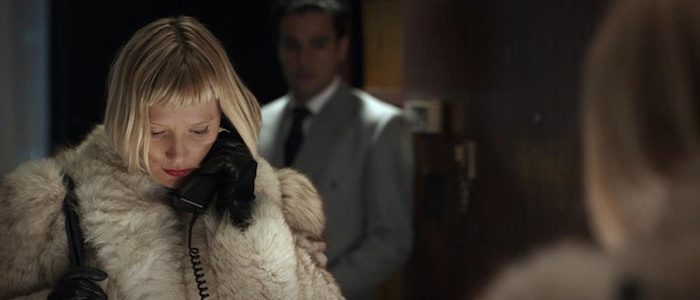
Late at night, distraught, and coldly standing over the crib, Reed stares down at his baby girl while firmly gripping the ice-pick behind his back when he suddenly hears his wife calling him to bed. This opening scene exemplifies director Nicolas Pesce’s ability to draw an audience in and immediately set an unnerving tone. His debut film, The Eyes of My Mother, is an eerie black-and-white horror story filled with depravity and disturbing imagery that, like the anti-hero’s surgical knife, cuts deep into the comfort zones of an audience with razor-sharp precision. Inspired by the novel written by Ryû Murakami (author of Audition), Piercing takes a different approach by combining elements of horror and black comedy to deliver a macabre story about trauma as a catalyst for murder.
Reed (Christopher Abbott) is a man with a plan. Spoken in an monotonous and logical voice-over, he reveals his sinister scheme that consists of murdering a prostitute by entrapping her in a hotel room, engaging in light BDSM by way of bondage, and dismembering her body all to alleviate the desire to kill his baby. He methodically plays out the scenario and writes down the intricacies of the execution, including the amount of time each action is expected to take and the physical effects of the devices he will be administering. Donning a blonde bob and black leather gloves, a turbulent hooker by the name of Jackie (Mia Wasikowska) willingly walks into his trap. Carefully avoiding the possibility of leaving his fingerprints, Reed attempts to awkwardly seduce and kill her, but Jackie has some demons (and kinks) of her own. Set over the course of one night, their power dynamics fluctuate as the story twists and turns into a deranged nightmare.
The film is shot with elements of giallo, split frames reminiscent of Brian de Palma and Quentin Tarantino, and a set design with call backs to Wes Anderson. Production designer Alan Lampert captures the ‘70s color palettes implicative of Italian horror films in terms of both color and seductive simplicity. The hotel Reed checks into is sleek and has masculine color palettes of green, gold, and black while the power appears to belong to him. When there is a shift in dynamic at Jackie’s apartment, the set design is darker and feminine with deep red carpet and cherrywood paneling as she gains traction in their cat and mouse game of violent seduction. Outside shots of the city appear to be constructed out of cardboard miniatures. The artificial exteriors juxtapose the lively occurrences within the building and serve as a reminder that there is a deceptively deeper meaning to the characters on screen.
Elements of BDSM are threaded throughout but are void of any safe, sane, and consensual behavior. Reed and Jackie alternate between dominant and submissive roles, the use of bondage is applied both literally and metaphorically by way of flashbacks from Reed’s childhood traumas, and the notion of consent is blurred through lack of communication. Their relationship oscillates and at times is unclear if their situation is providing the characters fear or pleasure, which is ultimately a strength in the narrative that ties into its suspense and sharp plot deviations.
One comedic aspect of the film resides with the use of dialogue. There are moments where Reed thinks that Jackie actually wants to die and flirts with the idea that he will be her killer. In order to assess the gravity of his situation and how to get back to his original plan, he calls his wife (Laia Costa) to casually ask for her advice as though he was picking out an outfit to purchase and needed her input first. Sound design is crafted in a cunning manner with fantastic use of foley and other giallo throwbacks by way of the musical mayhem from Goblin. The pantomiming scenes of Reed acting out the murder ahead of time include the sounds that Jackie’s body would make getting dragged across the floor or her limbs being sawed off in the bathtub as her blood drips down the drain. It’s a well-executed and unique use of sound that ties into the dark comedy aspects of the film.
Wasikowska delivers a delightfully deviant performance with her ambiguity and unpredictable nature, which serves as a perfect character foil to Reed, who is calculated and meticulous. Abbott conjures up terror and laughter on par with Christian Bale’s performance as Patrick Bateman in American Psycho as he balances the embodiment of a lingering threat and comical character. Despite their strong performances, the narrative is disjointed in its attempt to explain the characters’ backstory through drug-induced flashback sequences. It hits the surface but does not elicit a strong arc or deeper emotional response from the audience. Decorative aspects of the film instead imply glimpses into the characters through lavish costume and set design.
Regardless, Pesce delivers a carefully crafted sophomore feature that explores the dangerous limits taken to rectify trauma and fulfill various desires. A sick and stylish love letter to giallo films of the ‘70s, Piercing is cinematic kink at its finest.
/Film Rating: 8.5 out of 10
The post ‘Piercing’ Review: Nicolas Pesce’s Latest is a Dark Comedy Pleasure Spiked With Pain [Fantastic Fest] appeared first on /Film.
from /Film https://ift.tt/2Rjy9L5



0 Comments